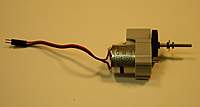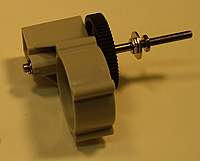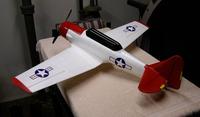Comments (22)
Add Comment
-
 Views: 1388
Views: 1388
Laying the starboard wing with the bottom side up (because that's where the convex side of the warp was) the wing is weighted down with some steel blocks, or any kind of small heavy objects you can find. -
 Views: 1217
Views: 1217
The port wing is layed with the top side up in this case, gently heated for maybe 30 seconds, allowed to cool for 5 minutes, then checked for progress. -
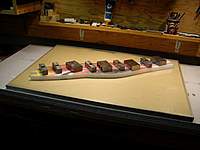 Views: 1265
Views: 1265
Same with the fuse. Convex side up, gently heated for 30 seconds or so, then cooled and checked. Go SLOW and do it in steps. -
 Views: 1209
Views: 1209
The end result is a pair of wing halves shown that are dead straight to each other, and ready for assembly. Remember, the key is to work slowly! -
 Views: 1211
Views: 1211
AUW of 15.6 ounces and powered by a ThunderPower 3s 1320, running a GWS 9x5 HD prop. Powered by E-Flite Park 400 920 kV motor. -
 Views: 1228
Views: 1228
19+ ounces of thrust, 36 mph top speed, on only 83 watts of power, pulling about 7.7 amps at WOT.
-
 Views: 4450
Views: 4450
All the parts of our 3 piece adapter, ready to install. -
 Views: 4004
Views: 4004
Use a piece of Emory paper to smooth out the prop shaft, and to get rid of any dirt, gum deposits, or dirt. Then wipe clean with alcohol. -
 Views: 5130
Views: 5130
Slip the first piece on and make SURE it bottoms out on the prop shaft. Note that while it's bottomed out, it must NOT touch the motor base. This is most important! -
 Views: 4479
Views: 4479
Slide the second piece over the first. Make sure it's facing the right direction. -
 Views: 4356
Views: 4356
Attach the prop, then use the cone shaped spinner to tighten everything down. A fat nail through the hole in the spinner gives lots of leverage for tightening.
-
 Views: 1142
Views: 1142
Weight without battery is 12.9 ounces. -
 Views: 1031
Views: 1031
With a heavier battery than it really needs, it weighs 15.5 ounces AUW. -
 Views: 1398
Views: 1398
Nose mounted E-Flite Park 920kV swinging a GWS 9x5 DD Direct Drive prop. -
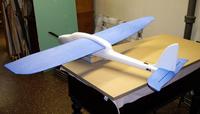 Views: 1275
Views: 1275
Rear mounted Dymond D47 servos. 4.7 grams of pure precision... :) -
 Views: 1183
Views: 1183
E-Flite Park 400 920 kV buried in nose of the Easy Star. Down/Right thrust already built into mount.
-
 Views: 1864
Views: 1864
No matter which way we orient the servo arm, this is as close to 90° as we can get! The 10" position represents 90°. We are about 3/8" off of plumb! -
 Views: 1521
Views: 1521
With the "Sub Trim" feature set to -32, we now have a perfectly centered servo arm, at 90° to the servo body. -
 Views: 1467
Views: 1467
Full transmitter stick deflection to the left results in 2 1/4" left travel, as shown in the picture. -
 Views: 1387
Views: 1387
Full transmitter stick deflection to the right results in the same 2 1/4" of right travel.
-
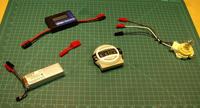 Views: 1500
Views: 1500
All the parts of our 3 phase discharger. The small 2-into-1 pigtail is for the maximum discharge rate of around 2.4 to 2.5 amps. -
 Views: 1272
Views: 1272
By using the brown wire from the tail light assembly, and the black ground wire, we can discharge our battery at between .5 and .6 amps. -
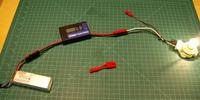 Views: 1233
Views: 1233
By using the white wire from the tail light assembly, and again the black ground wire, we can now discharge our battery at between 1.8 and 1.9 amps. -
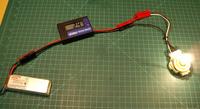 Views: 1295
Views: 1295
By pig-tailing the brown and white wires, and again using the black wire as ground, we can now light both filaments of the bulb and discharge our battery at between 2.4 and 2.5 amps.
-
 Views: 1650
Views: 1650
With a single Z-Bend, notice how the control rod is acting at an angle to the control horn. The control arm is actually tugging sideways on the rod! This places undue stress on the servo and ESC, and causes sloppy control surface response. -
 Views: 1604
Views: 1604
With a double Z-Bend, the control rod is now acting in a manner that puts the least stress on the control arm, the servo, and the ESC. The control rod is now acting in the same plane of movement as the control horn. -
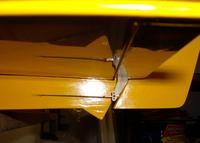 Views: 1709
Views: 1709
A side view of the completed alignment. Clean, precise, and professional! -
 Views: 1461
Views: 1461
I've tried them all, but the Hangar 9 brand Z-Bend Pliers #HAN 119 are the cream of the crop; and the cheapest, too!
